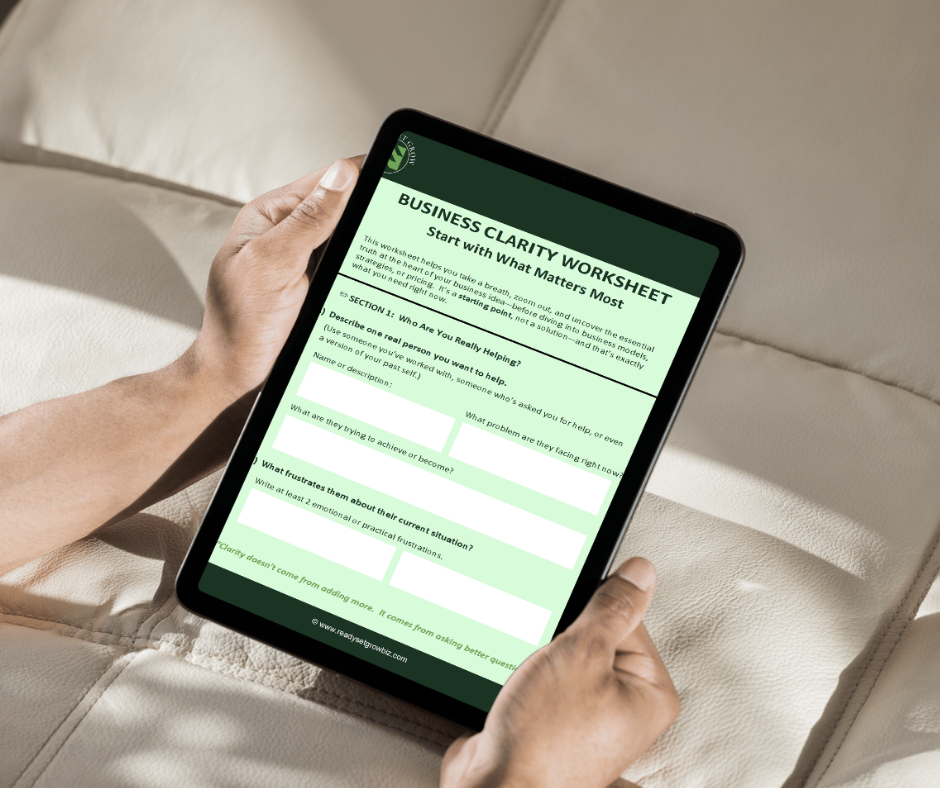From Vision to Reality: Crafting a Business Model That Works
Jun 26, 2025
When Clarity Hides Behind Complexity
A few years ago, I was working on new processes for one area of my accounting firm. I’d spent a lot of time preparing diagrams, mind maps, and descriptions for the perfect system.
But when it came time to explain it all on a Zoom call with an app developer, I wasn’t surprised with what happened next.
My voice wavered and I spoke in circles.
I was overwhelmed by my own work—paralyzed by a web of interlocking ideas that had become complicated. Sensing this, the developer interrupted and said something not as polite but with the same message as:
“Look lady, I don’t have time for this. Call me back when you figure out what problem you are trying to solve.”
After my ego had time to cool down, the fog started to clear.
The Hidden Trap: Building on Assumptions Instead of Truths
When most new entrepreneurs set out to build their business model, they reach for the nearest framework such as a Business Model Canvas, a SWOT analysis, or a downloadable template that promises clarity.

If you’re curious, the Business Model Canvas by Strategyzer is a widely-used tool that outlines nine key components of a business model.
While resources like this can be helpful, they often mask a deeper issue: They start with boxes to fill in—not with clarity about the problem you’re solving, who you’re serving, or why your business should exist in the first place.
You can’t build a sustainable business on borrowed thinking.
A model built on surface-level assumptions—what others are doing, what you think your audience wants, or what seems trendy—may look impressive on paper but will crumble after a short time. Instead, lasting business models come from asking the right questions and cutting through the clutter first.
Back to Basics: The Components That Actually Matter
Here’s where we start again—not with templates, but with truths. Below are the core components of a business model, deconstructed into their simplest form:

1. Your Customer (Who Are You Really Helping?)
This isn’t a demographic or a persona template. It’s a real person with a real problem.
What are they trying to change in their life or work? What frustrates them? What excites them?
2. The Problem (And Why It Actually Matters)
Strip away the industry buzzwords and ask: What’s broken that needs fixing? Not just a surface inconvenience—but the root of the issue your customer faces.
✅ Tip: If you can’t describe the problem in one sentence, you may not fully understand it yet.
3. The Value (What Are You Really Offering?)
It’s not a product. It’s not a service. It’s not even software or a template.
Here what it is: Transformation. It's helping someone go from where they are to where they want to be, with your help.
🎯 Stay tuned for a blog I will be writing about defining your value proposition.
4. Your Advantage (What Do You Already Have?)
Resources are often misunderstood as needing to be external. But your experience, insights, time, and connections all count. What do you have that others might overlook?
5. The Delivery and Cost Model (How Will It Sustain Itself?)
Now, and only now, do we begin to talk about the details of the product or service, its delivery, and pricing. Why? Because the how is only meaningful after the why and who are solid.
Simplicity Is Strategic—Not a Lack of Ambition
That Zoom call reminded me of something I now teach others:
Complexity is not the same as sophistication.

In fact, complexity often hides indecision, fear, and unclear thinking.
When you cut through it and start from fundamental truths, you build a model that’s not just viable—it’s resilient.
I ended up solving the problem by going with a much simpler solution, one that my clients are happy with. I avoided spending a lot of time, money, and stressful back and forth with the app developer.
The most effective business models aren’t bloated; they’re focused. They solve one meaningful problem well and grow from there.
Your Roadmap to Growth Begins Here
If you're feeling overwhelmed by business planning or stuck in a loop of second-guessing, you're not alone. Many new entrepreneurs fall into the trap of over-planning and under-clarifying.
Ready Set Grow was created to guide you through that fog with a structured, human-centered approach. We help you simplify—not by doing less, but by learning and concentrating on what matters most.
💡 Let’s Take the First Step Together
 Access our free Business Clarity Worksheet below from our Resource Library (and enjoy ongoing access to every guide, template, and worksheet). Start defining your customer, problem, and value—without the overwhelm.
Access our free Business Clarity Worksheet below from our Resource Library (and enjoy ongoing access to every guide, template, and worksheet). Start defining your customer, problem, and value—without the overwhelm.
Grab the worksheet below.
Or, if you're ready to build your entrepreneurial foundation with confidence, learn more about Module 1: Entrepreneurial Fitness—your first step in creating a sustainable business with purpose.

